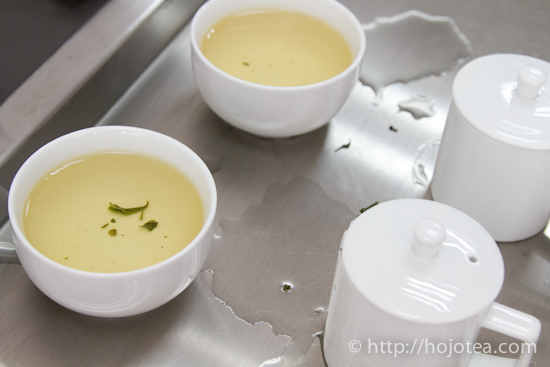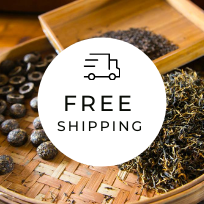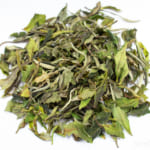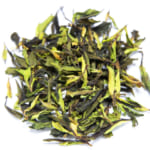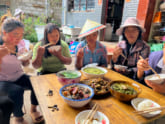- HOME >
- Tea Processing
The reason why Darjeeling first flush is “Green”.
The tealeaves of Darjeeling 1st flush is green in colour, despite this tea is categorized as black tea. I would like to explain the reason why.
Only the first flush has green leaves
There are 3 types tea produced in Darjeeling (India): Spring tea, the1st flush (March-April), 2nd flush ( May-June) and Autumnal tea (September – November). The color of 2nd flush Darjeeling and Autumnal Darjeeling are in orange-brown. These two types of tea literally look like a “black tea”. On the contrary, the leaves’ colour of Darjeeling 1st flush is green and its liquor colour is creamy yellow.
They made Darjeeling 1st flush GREEN in purpose
Some people say that Darjeeling 1st flush is green because it has less polyphenol and this is the character of a spring tea. However, this saying is not true. In China, there are many premium quality black tea which are plucked and produced throughout March and April. They are all in orange-brown color and rich in theaflavin. When tea is rich in theaflavin, we could tell by observing a golden ring formed inside the cup when tea is served.
So, why is Darjeeling 1st flush GREEN? We asked this question to the tea manufacturers, and they confirmed that they intentionally wanted to make Darjeeling 1st flush look green. Actually, Darjeeling 1st flush tea could be made into orange-brown colour if the manufacturers allow the tea to have sufficient fermentation. They purposely reduce its fermentation level so that it looks green and fresh. Darjeeling Autumnal tea could also be processed into green colour if the manufacturer wanted to do so.
Once upon a time, Darjeeling 1st flush was not green
According to the manufacturer, in the old days the color of first flush tea used to be similar to autumnal tea. It became so green nowadays due to market demand. The main buyers of Darjeeling 1st flush are from Japan, demands in Japan market played an important role in influencing the fermentation level of Darjeeling 1st flush. For now, all the tea gardens in Darjeeling process lighter fermented 1st flush tea, that is why all the 1st flush tea we see in market are in green colour.
The reason why the 1st flush tea is green
There is a little secret in the process of making a Darjeeling 1st flush.
Due to its long withering period, the moisture level in tealeaves reduced and resulted a slow fermentation to take place
The withering process is the key process for making a black tea. Withering is a process where tealeaves were spread evenly over a perforated plate or bamboo tray and gradually reduced its moisture content .The objective of withering it to enable rolling process to be carried on easily. With lower moisture content inside the leaf, its texture gets softer and more elastic. Once the leaves have less moisture content, it takes a longer time for the leaves to ferment (after the rolling process) as it became harder to activate the oxidation of enzyme inside the tealeaves. It is just like a dehydrated apple can hardly change into brown colour, even if it is cut in half and exposed to the air.
less fermentation
The fermentation process is carried out after rolling process. Tealeaves were spread over a stainless steel tray and left alone for some time. Usually the time spent for the fermentation of 1st flush is shorter than autumnal tea. The 1st flush leaves hardly turn brown due to lower moisture level, even if its fermentation time was as long as autumnal tea’s.
Darjeeling 1st flush withering process is same as Oolong tea processing
The primary objective of withering is to naturally activate the oxidation of enzymes by using dehydration method. As a result, tealeaves produced from withering give a very sweet floral flavor. In fact, Oolong tea was made in the same way. We met a few tea estate managers in Darjeeling who dare to say that Darjeeling first flush is a type of “Oolong tea”. In any case, Darjeeling 1st flush is a semi-fermented tea. It is too green to be listed as black tea. The major difference between Darjeeling 1st flush and Oolong tea is the sequence of its process.
Oolong Tea Process
Withering(Fermentation) → Heating(Inactivate Enzyme) → Rolling→ Drying
Black Tea Process
Withering → Rolling → Fermentation → Heating(Inactivate Enzyme)→ Drying
For making Oolong tea, the tealeaves were heated right after the withering process in order to stop the enzymatic activity. As for the Darjeeling 1st flush, tealeaves were not heated after withering process. In stead, rolling process will be carried out and subsequently tealeaves were fermented on the tray by themselves.
Taiwan Oolong tea which gives very refreshing ‘green tea’-like flavor are produced from skill laboured withering process. As soon as withered tealeaves start producing a desired flavor, then they will be heated immediately to stop further oxidation of the enzyme. As for Darjeeling 1st flush, tealeaves are not heated after the withering process. It subsequently rolled and fermented right after the withering process. Due to the fermentation process after withering and rolling, its flavor becomes a little thicker and smoother (more matured).
The future development of Darjeeling 1st flush
The identical floral flavor of Dajeeling 1st flush was produced during withering process. The dehydration of leaves triggers the oxidation of enzyme. What if tealeaves were heated right away to stop the enzymatic oxidation? This perhaps could create a hybrid tea that has a mixed character between a green tea and Oolong. I am not hoping for such hybrid tea to be made from Darjeeling. But there is a chance that such tea will be produced in future.
Related Articles
How to get the latest update on HOJO Tea?
1. Follow Twitter, 2. Click "Like" on Facebook, and 3. Subscribe in newsletter. You can have the latest tea news from HOJO Tea.
 Subscribe the Newsletter to enjoy the privileges
Subscribe the Newsletter to enjoy the privileges- You may receive a free sample upon purchase, or you may have the priority to purchase special products. So please remember to subscribe our newsletter as well as the social network.
- Yunnan Chun Jian Green Tea from High Mountain Gardens
- Yunnan Chun Jian Green Tea is now available.This tea is made from naturally grown leaves harvested from high mountain gardens at 2100m above sea level. It has a rich, long-lasting lingering aftertaste, comparable to raw Pu-erh tea. Yunnan as a Distinctive Tea Growing Region Over the past 20 years, we have explored a wide range …
- Limited Loose Leaf Release of 2025 Da Xue Shan Wild Raw Pu-erh Tea
- We have released the 2025 loose-leaf version of Da Xue Shan Wild Raw Pu-erh Tea.This tea comes from wild tea trees that grow naturally in the high mountains of Yunnan Province, at elevations above 2000 meters. This year, we were only able to secure a small quantity for retail, and the current release is available …
NEW ARTICLES
 Yunnan Chun Jian Green Tea from High Mountain Gardens
Yunnan Chun Jian Green Tea from High Mountain Gardens- Yunnan Chun Jian Green Tea is now available.This tea is made from naturally grown leaves harvested from high mountain gardens at 2100m above sea level. It has a rich, long-lasting lingering aftertaste, comparable to raw Pu-erh tea. Yunnan as a Distinctive Tea Growing Region Over the past 20 years, we have explored a wide range …
 Limited Loose Leaf Release of 2025 Da Xue Shan Wild Raw Pu-erh Tea
Limited Loose Leaf Release of 2025 Da Xue Shan Wild Raw Pu-erh Tea- We have released the 2025 loose-leaf version of Da Xue Shan Wild Raw Pu-erh Tea.This tea comes from wild tea trees that grow naturally in the high mountains of Yunnan Province, at elevations above 2000 meters. This year, we were only able to secure a small quantity for retail, and the current release is available …
 2025 Da Xue Shan Wild White Tea Now Available from Yunnan
2025 Da Xue Shan Wild White Tea Now Available from Yunnan- The 2025 harvest of Da Xue Shan Wild White Tea is now available. Crafted from truly wild Camellia taliensis trees growing naturally in the high-altitude forests of Yunnan, this tea offers a purity and character unique to its origin. This year’s unusually dry climate during the withering season was ideal, resulting in a floral and …
 Why Do Some Teas Taste Astringent? Exploring the Causes and Mechanisms of Astringency
Why Do Some Teas Taste Astringent? Exploring the Causes and Mechanisms of Astringency- Tea can range from having no noticeable astringency to possessing a very strong one. What causes this astringency? This article explores the causes and mechanisms behind astringency in tea. Causes of Astringency Astringency arises from the binding of tea components to proteins in the oral cavity, creating a sensation of tightness or dryness. The tongue …
 The Impact of Heat Sources on Tea Flavor
The Impact of Heat Sources on Tea Flavor- It is widely recognized that the material of a kettle plays an important role in shaping the taste of water for brewing tea. Yet, an often overlooked but equally significant factor is the type of heat source used to boil the water. Different heat sources, whether gas, electric, charcoal, or wood fire, can impart distinct …
 New Release of High Mountain White Tea
New Release of High Mountain White Tea- We are pleased to introduce our High Mountain White Tea, sourced from a unique tea garden with two key features: 1. Located at an altitude of 2200-2300m2. Completely wild and untended The ideal natural conditions of this garden result in tea of exceptional quality, offering a pure and gentle, nourishing taste. High Altitude and Wild …
 New Release of Da Xue Shan Wild White Tea 2024
New Release of Da Xue Shan Wild White Tea 2024- We have released the 2024 Da Xue Shan Wild White Tea Loose Leaf. This tea was produced under our direct supervision during our stay in Yunnan Province, ensuring meticulous production management on site. Definition of Wild Tea in Yunnan Province People in Yunnan strongly associate Camellia taliensis with wild tea, regardless of where it is …
 New Release of Wild Pu-erh Jasmine Pearl
New Release of Wild Pu-erh Jasmine Pearl- Out of curiosity, we decided to create a jasmine tea based on Da Xue Shan Wild Raw Tea. This resulted in an exceptionally rare tea, not only in Japan but also in China. Custom Production Network for Jasmine Tea At our store, we source various types of base teas from different regions during the spring. …
 2024 Overview: Our Yunnan White Tea Quality, Process, and Weather Insights
2024 Overview: Our Yunnan White Tea Quality, Process, and Weather Insights- One of the teas we’ve been focusing on in Yunnan Province is white tea. Historically white tea has been produced in both Fujian Province and Yunnan Province for a long time. While white tea from Fujian Province is well-managed during processing, we are dissatisfied with the quality of the raw materials due to the use …
 Yunnan’s Hospitality Culture: Expressed Through Meals
Yunnan’s Hospitality Culture: Expressed Through Meals- In China, as a form of greeting, it’s common to say “你吃饭了吗?” which means “Have you eaten?” However, in Yunnan Province, the phrase “吃饭” is often used in various situations, more like “Eat, eat,” serving as an invitation to share a meal. Yet, with prolonged exposure to Yunnan, one comes to understand that these meal …
Shop Info

Address:Lot No. T-215, 3rd Floor, The Gardens Mall, Mid Valley City, Lingkaran Syed Putra, 59200 Kuala Lumpur
Tel: +603-2287-4537
Business Hour: 10am to 10pm
Category
- New Arrival at HOJO Online Shop
- Featured Articles
- Newsletter
- Types of Tea
- Origin of Tea
- Teapot and Tea Equipment
- Tea Column
- How to enjoy tea
- Tea Processing
- How to choose quality tea
- Tea constituents and functional effect
- Safety of Tea
- Foods
- Tea Business Operation
- Hobby and Outdoor Activity
- Ranking of Tea
- Video
- FAQ
- Media Release
Profile

- AKIRA HOJO
- I invite you to experience my tea selections.I was born in Nagano, Japan. In university, I studied agricultural chemistry, and I have the master degree in food science. I worked in Japanese food industry for 10 years. I involved in R&D, QC and QA. As a factory manager, I implemented ISO9000 series and managed the factory.
- The Art of Tea Magazine
- We posted the article on “The Art of Tea Magazine No.9, the magazine is published in Taiwan. We featured some scientific view about the tetsubin
- New Straits Times
- The Malaysian National Newspaper, New Straits Times featured HOJO Tea on 17-Oct-2007.


